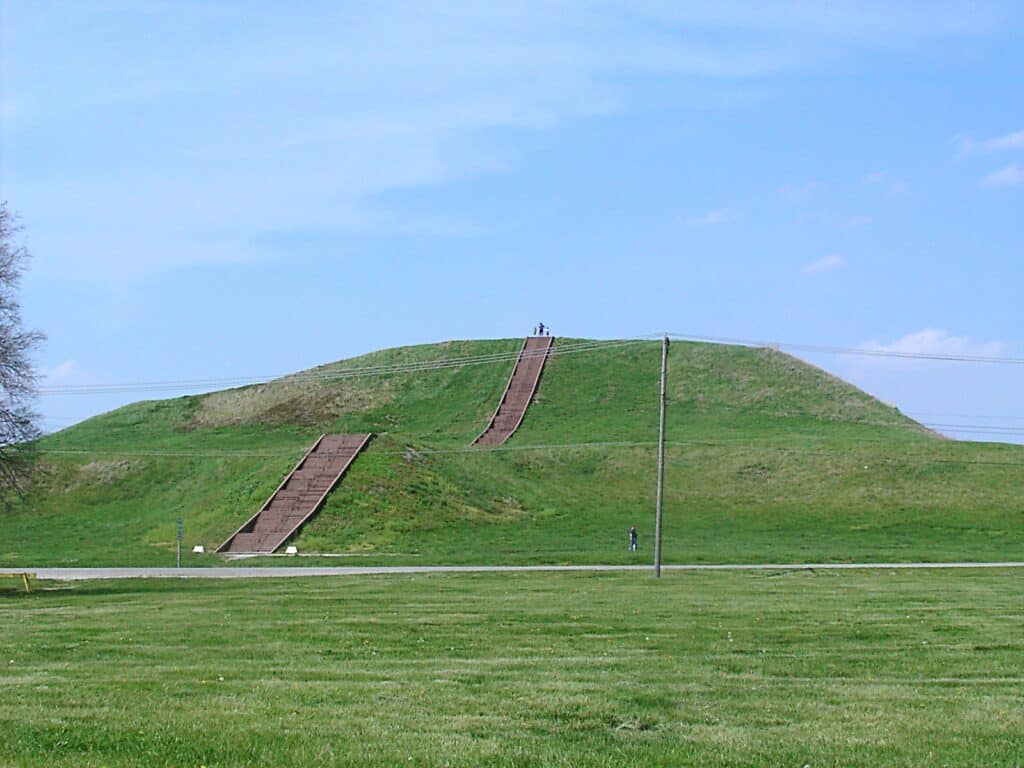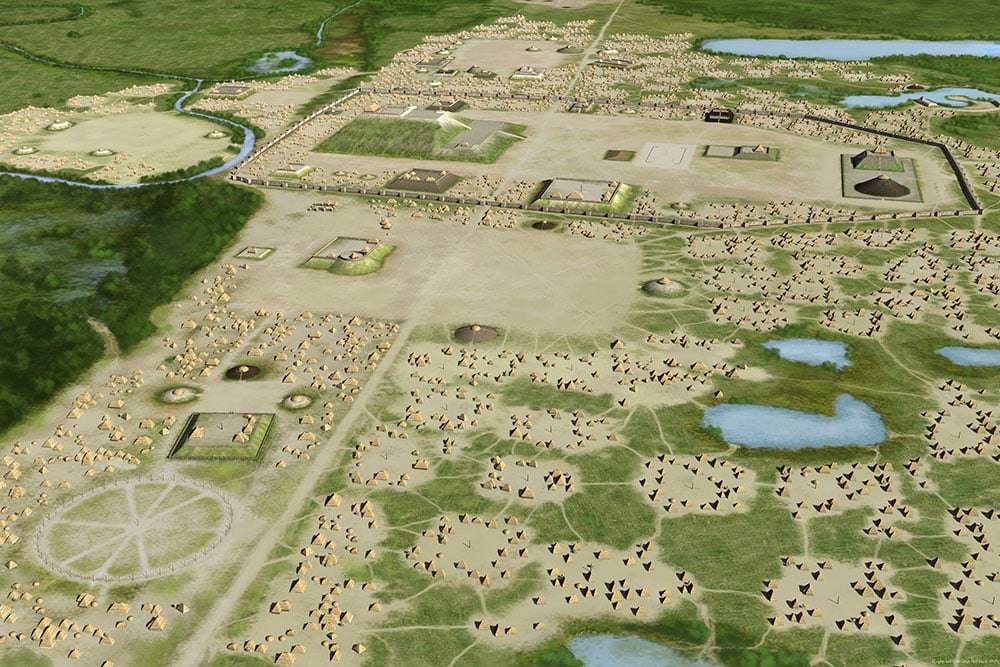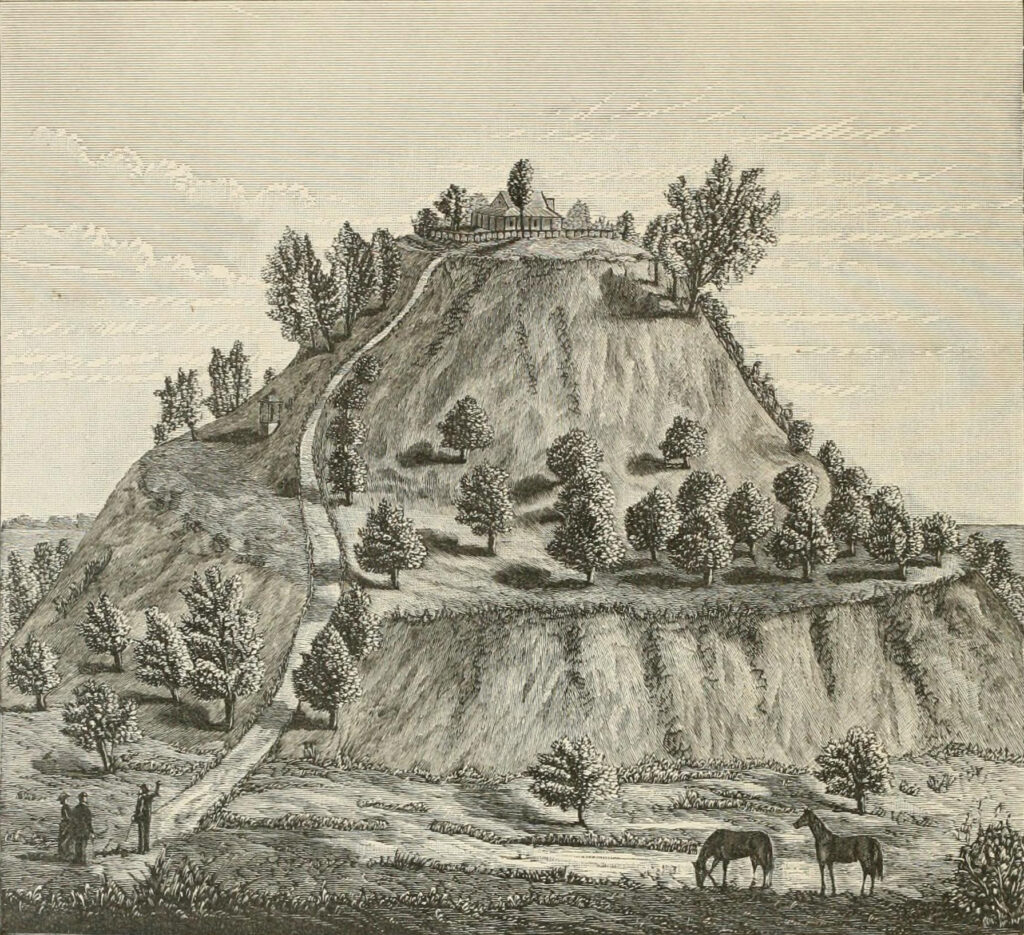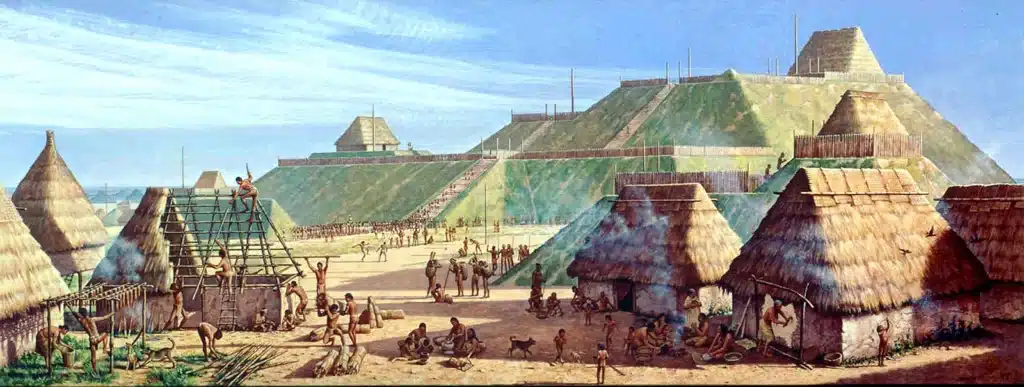Imagine walking through a bustling city of thousands of people. There are towering earthen mounds and busy marketplaces, all nestled in the heartland of America over a thousand years ago.
Although it sounds like a fantastical dream, it was a real place – Cahokia.
The history of Cahokia is a captivating tale of an indigenous civilization that flourished for centuries in what is now southeastern Illinois, in the United States.
Cahokia was a pre-Columbian city-state. It was once the largest urban center north of Mexico. It was home to a vibrant culture that rivaled the great cities of Europe at the time.
Despite its grandeur, Cahokia was overlooked and dismissed as a footnote in history. It was lost among the many misconceptions of what indigenous American societies looked like.
This oversight is a tragic mistake. Cahokia provides a unique perspective on the richness and complexity of indigenous cultures. Common misperceptions of indigenous peoples as primitive, unsophisticated, and lacking in complex societies are challenged by their existence.
At its peak, the city-state boasted a massive population. It included an intricate network of trade, political, and religious systems that were on par with contemporary European civilizations.
The history of Cahokia is not just a tale of a forgotten past. It’s an urgent reminder of the rich diversity of an indigenous civilization that was lost to history.

The Mississippian Culture
Cahokia was located in what is known today as the Mississippian culture. It was a Native American civilization, which thrived in the Midwestern, Eastern, and Southeastern United States from the period of around 800 to 1600.
This culture was marked by the notable development of sedentary lifestyles, agriculture, and centralization. And especially the construction of large earthen platform mounds.
One of the civilization’s most distinctive traits was mound-building. Archaeologists and anthropologists highlight this trait as a key commonality that sets it apart from other indigenous cultures.
Mound-building was particularly noteworthy at Cahokia. Thousands of trees were felled to construct defensive fortifications.
The Mississippian way of life began to take shape in the Mississippi River Valley, from which it derived its name. It consisted of many different settlements and population centers.

These settlements were closely linked together by loose trade networks and communication. Cahokia was by far the largest and, potentially, most influential of the many urban settlements and satellite villages.
The Mississippian culture evolved through three major periods.
The Early Mississippian period lasted from around 1000 to 1200. During this time, different groups began to abandon typical lifestyles in exchange for lifestyles of increasing complexity, sedentism, centralization, and agriculture.
The Middle Mississippian period lasted from 1200 to 1400. It was the apex of the Mississippian era. Most notably, it included the expansion of the great metropolis and ceremonial complex at Cahokia, the formation of other chiefdoms, and the spread of art.
Finally, there was the Late Mississippian period of 1400 to around 1540. During this time, there was an increase in warfare, political turmoil, and large-scale migrations. The population of Cahokia dispersed early in this period. Perhaps they migrated to other rising cities, which led to the decline and fall of this city-state.
The Rise of Cahokia
Based on the archaeological evidence, Cahokia was established during the Late Woodland period, around 600 or 700. However, their signature mound building did not start until the emergence of the Mississippian cultural period in the 9th century.
Unfortunately, the people who lived in Cahokia did not leave any written records. But the elaborate community, including Woodhenge, the mounds, and the burial sites, reveals their complex and sophisticated society.
The original name of the city is unknown. The mounds were named after the Cahokia tribe, who were living in the area when the first French explorers arrived in the 17th century.
This tribe was not necessarily descended from the earlier Mississippian-era people, however. The Cahokia area was abandoned by its original inhabitants centuries before the Cahokia tribe arrived.
Constructing the city’s earthen mounds certainly required significant manual labor. This involved practices like excavation, digging, and transportation of materials.
The city’s construction is estimated to have used about 55 million cubic feet of earth. Anthropologists expect it would have taken several decades to accomplish.
There were highly planned ceremonial plazas around the mounds, connected by laid-out pathways and courtyards. This suggests that the city was a central religious pilgrimage site with homes for thousands of people.
It is also likely that skilled administrators and a large labor force were needed to plan, build, and maintain the site.
Not much else is known about the early development and rise of Cahokia as a major urban center. Whether for political, cultural, or geographical reasons, Cahokia continued to grow rapidly.
Cahokia eventually became the primary center of the Middle Mississippian culture, The population reached tens of thousands at its peak.
Today, Cahokia Mounds is the largest pre-Columbian archaeological site north of Mexico. It’s also the earliest of the large Mississippian settlements. It offers an invaluable glimpse into the history of the ancient civilization.
Cahokia At Its Peak
Cahokia was the largest urban center north of the great Mesoamerican cities in Mexico and Central America. It even rivaled the size and splendor of other global metropolises.
After gaining a foothold in the region, its population grew rapidly. Population estimates ranged from as low as 6,000 to as high as 40,000 people. They all lived in the main urban center and the outlying farming villages that supplied it.
If the higher population estimates are correct, then Cahokia was larger than any city in the United States that followed until the 1780s, when Philadelphia’s population grew beyond 40,000.
It may have even had a larger population than contemporaneous London and Paris across the Atlantic.
Cahokia was a carefully planned city. It was designed with clearly defined zones for administrative and ceremonial functions, elite compounds, residential neighborhoods, and suburbs.
The enormous central plaza covered nearly 40 acres and featured numerous immense earthworks. This included the pyramidal Monks Mound. This was a structure that rose to 100 feet, covered more than 14 acres, and contained more than 25 million cubic feet of earth.

An incredible structure to behold, Monks Mound is believed to have held a strong significance. Anthropologists believe that it housed a building some 100 feet long, nearly 50 feet wide, and 50 feet tall. This would have been the seat of governance for Cahokia.
Cahokia was located near the junction of the Mississippi, Missouri, and Illinois rivers. This location made it a strategic location for trading far and wide, also making it a major economic hub.
Bartering was the norm for trade at the time. Exotic items such as copper, Mill Creek chert, and whelk shells were exchanged among settlements.
Cahokia was particularly skilled at manufacturing hand tools. This was an important good for trading and for spurring economic activity that allowed the city to thrive.
Despite Cahokia’s incredible success, it faced challenges. Keeping a steady supply of food and waste disposal for the large, dense population was a constant issue. This may have led to polluted waterways and an unhealthy living environment.
However, the city continued to attract immigrants from all over due to its social and political attractions.
Cahokia is a testament to the incredible achievements of pre-Columbian civilizations in the Americas. The importance of agriculture, trade, and vibrant economic activity were all crucial to its success.
Agriculture and Society
Agriculture played a central role in society at Cahokia. Most members engaged in farming.
Corn, or maize, was the primary crop. The largest zone of high-quality soils in the local region was located immediately to the east, where large corn outfields were situated.
This area was located on the floodplain and along its borders. It provided the ideal conditions for successful agriculture.

Despite the advantages of this mixed agricultural strategy, it ultimately proved unsuitable for the much denser population at Cahokia.
The city was located on a major local tributary of the Mississippi River. It had access to diverse habitats, including expanses of open water and marshes that provided fish, which was the most important protein source for the populace. However, the sheer number of people living within the city made it difficult to sustain such a mixed agricultural system.
Multicrop infields and house gardens were situated within the city, on soil that was enriched by prior human occupation. However, these small-scale gardens were not sufficient to sustain the large population at Cahokia. Eventually, the city began to decline as a result of environmental degradation and other factors.
Despite this, the agricultural practices of Cahokia had a profound impact on the region. It influenced farming techniques and practices that continue to this day.
The Eventual Decline and Fall
Cahokia was once a bustling city. It was home to a vibrant, colorful society and a massive population of farmers, traders, and specialists.
However, the city’s decline and eventual abandonment around 1350 remains mostly a mystery to archaeologists. Scholars proposed various theories for the fall of Cahokia. But a lack of clear evidence has left much to speculation.
One commonly cited explanation for Cahokia’s decline is environmental degradation. The population at Cahokia relied heavily on wood for fuel and construction. This could have led to high levels of deforestation in the area.
This would have resulted in increased rates of runoff, erosion, and unseasonable summer flooding. This would have caused crops to fail and steady production to decline.
The economic and social consequences of such a development would have been disastrous. It would have led to starvation, changes in leadership, increased competition for land, and even potentially regional warfare.
However, recent research suggests that there is little evidence of human-caused erosion or flooding at Cahokia. Scholars now cast doubt on this hypothesis.
Instead, political and economic problems may have contributed to the community’s decline. Both social and environmental factors likely combined to produce whatever conditions led people to leave Cahokia.
Another possible cause is an invasion by outside people. But there is little evidence of warfare beyond the defensive wooden stockade and watchtowers that enclosed Cahokia’s main ceremonial precinct.
Diseases transmitted among the large, dense urban population are another possible cause of the decline.
The fall and decline of Cahokia remains a mystery. Scholars are largely unable to determine exactly what caused the rapid depopulation and abandonment of the great city.
Environmental degradation, political and economic problems, invasion, and disease are all possibilities, but no single explanation can fully account for the abandonment of the city.
Further research may provide additional insights into the decline of this once-great society.
The Legacy of Cahokia in Understanding America’s Past
The legacy of Cahokia challenges many preconceived notions of what indigenous cultures in North America were like and what they were capable of.
It demonstrates that many pre-Columbian societies were sophisticated and complex. They had advanced urban planning and monumental architecture.
The scale of Cahokia’s earthworks, such as the Monks Mound, is a testament to the engineering and construction abilities of the Mississippians. It’s also evidence of a refined societal hierarchy.
Cahokia also challenges the idea that indigenous cultures were static and unchanging. The city’s rise and fall demonstrates the ebb and flow of power and influence in pre-Columbian North America. It also highlights the ability of societies to adapt to changing environmental and social conditions.
The significance of Cahokia extends beyond its physical remains and its historical and archaeological value.
The site has become a symbol of the Native American heritage of the United States. It serves as a constant reminder of the rich cultures and impressive civilizations that existed and thrived in the centuries before European explorers arrived in the Americas.
The study and appreciation of Cahokia have furthered a growing recognition of both the complexity and diversity of indigenous cultures in North America. It challenges stereotypes and the simplistic representations of these societies.
Today, the site attracts visitors from around the world who come to marvel at the impressive structures and learn about the fascinating history of the early Mississippians and their incredible culture.
References
“Cahokia Mounds State Historic Site.” UNESCO World Heritage Centre. UNESCO. Accessed April 18, 2023. https://whc.unesco.org/en/list/198/.
“Cahokia Mounds.” Encyclopædia Britannica. Encyclopædia Britannica, inc. Accessed April 18, 2023. https://www.britannica.com/place/Cahokia-Mounds.
Hodges, Glenn. “Why Was the Ancient City of Cahokia Abandoned? New Clues Rule out One Theory.” Environment. National Geographic, December 7, 2021. https://www.nationalgeographic.com/environment/article/why-was-ancient-city-of-cahokia-abandoned-new-clues-rule-out-one-theory.
“Learn about Cahokia Mounds.” Cahokia Mounds. Cahokia Mounds State Historic Site. Accessed April 18, 2023. https://cahokiamounds.org/learn/.

